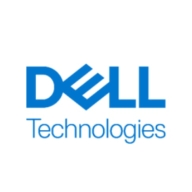

Dell PowerEdge R-Series and IBM Power Systems compete in the enterprise server market. Dell PowerEdge has an advantage in ease of deployment and customer support, while IBM Power Systems lead in performance and stability for demanding applications.
Features: Dell PowerEdge R-Series offers robust scalability, iDRAC for remote management, and integration with OpenManage. It is highly customizable and known for its reliability. IBM Power Systems excel in resource allocation and virtualization, offering integrated CPU power and operating system stability with AIX, making them ideal for large-scale applications.
Room for Improvement: Dell PowerEdge users have pointed out the need for better analytics and expanded NVMe support. IBM Power Systems would benefit from cost reductions and simplified licensing. Both brands should focus on improving support for AI and cloud technologies.
Ease of Deployment and Customer Service: Dell PowerEdge is praised for straightforward deployment and effective customer support, mostly in on-premise environments. In contrast, IBM Power Systems require more expertise for deployment but benefit from IBM's expansive support network. Dell stands out for resolving service issues swiftly.
Pricing and ROI: Dell PowerEdge is competitively priced, offering good ROI with extended use and transparent pricing, though high-end configurations can be expensive. IBM Power Systems are often pricier but provide exceptional performance and reliability, offering better value for intensive workloads, with advanced features that can justify the cost.
By not having to worry about it, I would estimate we save two to four hours a week, depending on what's happening, such as if we need to spin up a new server, which would contribute to more time if done the old way.
In my immediate case for antenna analysis, Dell PowerEdge Rack Servers offer a reduction from days of computing to half a day or hours.
The value of uptime to us is critical.
The return on investment is very high.
I would give Dell PowerEdge Rack Servers a ten because they're always able to answer all the questions we have; they reach a solution no matter how long it takes, and they don't give up.
It has always been scheduled maintenance, which says a lot for a production environment, as we haven't had to call in a trouble ticket for the actual hardware during its entire run.
Typically, the contacts we have on-site are very knowledgeable, they come in within a day and usually have it fixed and taken care of if there are issues.
I try to get my support calls pre-routed to the US; I'd rather wait a couple of hours for support becoming available there than going to support somewhere in the Philippines or Indonesia.
Technical support from IBM is excellent.
The scalability of Dell PowerEdge Rack Servers is excellent.
Any outages or blackouts are limited to particular servers, not affecting the whole chassis or enclosures.
We bought our product with scaling involved, and we've been scaling it up anytime we've needed more storage.
IBM Power Systems is a completely scalable solution.
Over four years, we've had less than 1 percent downtime.
There is a feature to update the server while it is running, so there is no need to restart.
We have truly not had any downtime on the infrastructure at all.
IBM just released IBM Power11 last month with significant improvements, eliminating the need for downtime in your environment.
We need to know about any upcoming updates so that we can plan accordingly.
The beneficial aspect of that feature was that we could skip the PowerStore and just have the Dell PowerEdge Rack Servers alone, as they also served as storage, which helped us save money.
This forces you to go up to a larger server to get the desired processor, which increases the cost.
IBM gives customers peace of mind.
They have been stable and running for years without performance downtime or significant disc failures.
Some customers find it cheaper due to contractual agreements, while others find it expensive, especially when scaling up.
The software associated with servers, like VMware subscription licenses, drives costs.
Initially when sizing it, people perceive IBM Power Systems as quite expensive.
They keep running for at least five to seven years without any issues.
With PowerEdge Servers, I don't need a one-to-one ratio redundancy, which leads to about eighty percent downtime reduction.
One of the valuable features is Active Directory, which helps in managing the network.
For over 13 years, IBM systems have been the most secure in the industry.
| Product | Market Share (%) |
|---|---|
| Dell PowerEdge R-Series | 27.4% |
| IBM Power Systems | 8.7% |
| Other | 63.900000000000006% |


| Company Size | Count |
|---|---|
| Small Business | 79 |
| Midsize Enterprise | 52 |
| Large Enterprise | 95 |
| Company Size | Count |
|---|---|
| Small Business | 17 |
| Midsize Enterprise | 18 |
| Large Enterprise | 42 |
PowerEdge R-Series delivers high performance, flexibility, and scalability for data centers. It supports demanding tasks with robust management tools and advanced cooling, providing reliability and efficiency across various workloads.
Engineered for large deployments, PowerEdge R-Series supports extensive configurations optimizing performance in data centers. With features like advanced cooling and energy-efficient architecture, it empowers organizations to manage heavy workloads while facilitating seamless scalability. It offers remote management, robust security, and integration with VMware ensuring operational excellence and high availability for business-critical applications.
What are the key features of Dell PowerEdge R-Series?PowerEdge R-Series is deployed across industries for virtualization, database hosting, and application servers. It supports environments like VMware and Hyper-V for AI, cloud infrastructure, and computing tasks. Widely used by finance, healthcare, and academia, it enhances reliability and efficiency of IT infrastructure.
We monitor all Rack Servers reviews to prevent fraudulent reviews and keep review quality high. We do not post reviews by company employees or direct competitors. We validate each review for authenticity via cross-reference with LinkedIn, and personal follow-up with the reviewer when necessary.